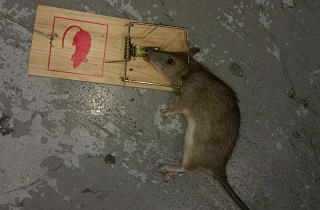Dealing with a dead rat in your home can be a challenging and unpleasant process because they are known to sneak into the tiniest crevices and other difficult-to-reach areas of your property.
In addition to being a terrible sight and smell, it can be harmful to your family's health as well as the health of your pets. Yet if you take the correct actions, getting rid of it can be a quick and straightforward operation.
In this article, we'll provide you some useful advice on how to get rid of a dead rat in your home, avoid a future infestation, and successfully manage one.
Disposing of the Carcass Safely
When disposing of the carcass, it is important to do so safely and responsibly to minimize the risk of exposure to harmful bacteria and diseases. Here are some steps you can take to dispose of the carcass safely:
Step 1: Locate the Body
The first step in getting rid of the body is to locate it. Dead rats can be found in various parts of your house, such as the attic, basement, garage, or walls. If you are not sure where the body is located, you can follow your nose. The smell of a carcass is strong and unpleasant, so it should not be difficult to locate.
Step 2: Wear Protective Gear
When handling a carcass, it is essential to wear protective gear. This will help prevent any potential health risks that may come from handling a decomposing animal. Gloves, a face mask, and goggles are recommended when handling carcasses.
Step 3: Dispose of the Body
Once you have located the body, you can begin to dispose of it. There are several ways to dispose of a dead rat, and the method you choose will depend on your preference and the location of the body.
- Use a Plastic Bag: Using a plastic bag is one of the easiest ways to dispose of a dead rat. Put on your gloves and pick up the dead rat, and place it in a plastic bag. Tie the bag tightly and dispose of it in the trash. Be sure to wash your hands thoroughly afterward.
- Use a Shovel: If the dead rat is located in your yard or outside your house, you can use a shovel to pick it up. Put on your gloves and place the rat on the shovel. Carry it to a location where it can be buried. Be sure to wash the shovel thoroughly afterward.
- Call a Pest Control Professional: If you are not comfortable handling a rat, or if it is located in a hard-to-reach area, you can call a pest control professional. They will have the necessary equipment to safely and effectively remove the rat.
Step 4: Clean the Area
After disposing of the rat, it is important to clean the area thoroughly. This will help prevent any potential health risks that may come from the rat's presence. Use a disinfectant and a cloth to clean the area where the rat was located. Be sure to wash your hands thoroughly afterward.
Step 5: Prevent Future Infestations
To prevent future infestations, it is essential to take steps to prevent rats from entering your home. This can include sealing any cracks or gaps in your home's foundation, cleaning up any food spills, storing your food properly, and keeping your home clean and clutter-free.
Health Risks of a Dead Rat
 Dead rodents can pose a serious health risk to humans. When a rodent dies, its body begins to decompose, which can release harmful bacteria and diseases into the air. If you come into contact with a carcass or its bodily fluids, you may be at risk of contracting a variety of illnesses, including hantavirus, salmonella, and leptospirosis. These illnesses can cause symptoms such as fever, headache, nausea, and muscle aches, and in some cases, they can be life-threatening.
Dead rodents can pose a serious health risk to humans. When a rodent dies, its body begins to decompose, which can release harmful bacteria and diseases into the air. If you come into contact with a carcass or its bodily fluids, you may be at risk of contracting a variety of illnesses, including hantavirus, salmonella, and leptospirosis. These illnesses can cause symptoms such as fever, headache, nausea, and muscle aches, and in some cases, they can be life-threatening.
It is important to handle a carcass with caution and wear protective gear such as gloves and a mask to minimize the risk of exposure. If you suspect that you have been exposed to a carcass and are experiencing symptoms, seek medical attention immediately.
How to Effectively Control and Remove an Infestation?
The best and most effective way to deal with a pest infestation is to consult an expert and get a professional pest control service for your property. Professional pest treatment is a highly recommended option because it produces the best outcomes. Also, you don't have to be concerned about a reoccurring infestation because frequent check-ins provide you the confidence that your property is safe.
In conclusion, it is important to get rid of a dead rat in your home as soon as possible to minimize the risk of exposure to harmful bacteria and diseases. When handling a dead rat, be sure to wear protective gear and dispose of it safely and responsibly. If you are not comfortable handling a dead rat on your own, consider hiring a professional to handle the situation for you.
Remember, a dead rat is often a sign of a larger rat infestation in your home, so it is important to take steps to prevent future infestations. This can include sealing entry points, keeping your home clean and clutter-free, and storing food properly. By taking these steps, you can help keep your home free of rats and minimize the risk of exposure to harmful bacteria and diseases.